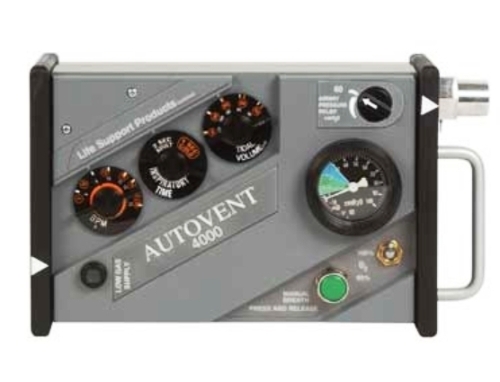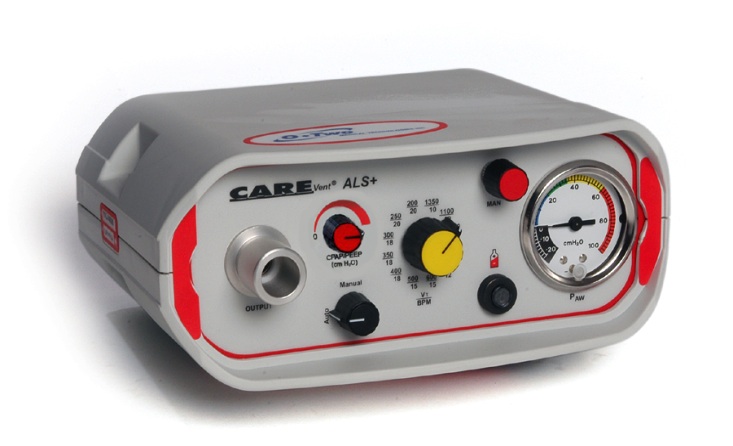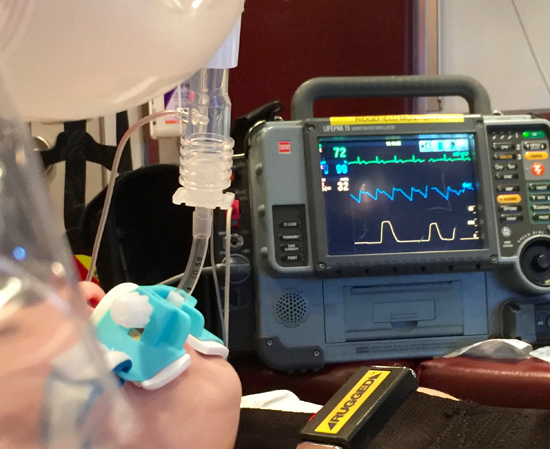Automatic Transport Ventilator/Resuscitator
Published (updated: ).

Transport ventilators, also known as portable ventilators, are mechanical ventilation devices designed specifically for emergency or transport scenarios. Like stationary ventilators, they help patients breathe by delivering either oxygen-enriched gas or room air into a patient’s respiratory system through invasive or noninvasive means.
Rescuers around the world still reach for a bag valve mask (BVM) to manually ventilate a patient in respiratory distress during transport. A BVM is a handheld device that functions as a face mask with a bag and valve attached – when a rescuer squeezes the bag, they are able to deliver room air or air from an attached oxygen tank to a patient. However, the BVM operator must control the pace of the air delivered, which can prove to be problematic since moving a patient not only disrupts a patient’s breathing pattern but also interferes with a rescuer’s ability to focus on them.
Transport ventilators, also known as automatic transport ventilators, can be configured to offer optimal breathing patterns and automatically deliver the oxygen and tidal volume a patient needs. A transport ventilator operator only needs to apply a mask or tube to the patient, select the appropriate settings, and allow the machine to deliver air to the patient. Automatic transport ventilators ensure that patients are breathing properly no matter where they are.

Using Transport Ventilators for Patient Care
Although smaller transport ventilators are beginning to appear in many ambulances, helicopters, and fixed-wing aircraft, automatic transport ventilators are primarily used for transporting patients in an inter- or intra-hospital setting. Here are a few common scenarios where a portable ventilator may be used:
- Providing ventilatory support to an ICU patient
- Transporting a patient to and from the operating room
- Helping patients breathe during certain operations
- Transporting intensive care patients to another hospital
Since they can be used for a variety of patients, transport ventilators are a mainstay within modern hospitals. They are the most effective way to ensure a patient is breathing properly while they are being moved. However, care teams should follow a standard procedure during transport scenarios to ensure patients can be transported safely and efficiently.
Before use, make sure your ventilator is fully charged, properly connected, and is generally in full working order. By ensuring this ahead of time, the ventilator can be applied almost immediately in case of an emergency.
After the patient has been outfitted with a transport ventilator, they should be moved to a portable bed that is suitable for the impending transport conditions. Before you begin moving the patient, make sure they are positioned in a way that is comfortable and does not impede airflow. Keep an eye out for any adverse symptoms during the transport process, and immediately take measures to reorient the patient or ventilator to ensure they are receiving enough oxygen.
The Benefits of Automatic Transport Ventilators
All ventilators help care teams maintain the four functions behind basic life support — ventilation, oxygenation, circulation, and perfusion. However, a stationary ventilator or bag valve mask doesn’t deliver the same benefits as an automatic transport ventilator. Care teams often call for a transport ventilator due to several key benefits:
- Easy to maneuver — When the care team needs to move a patient, a transport ventilator can be affixed to their bed.
- User-friendly interface and controls — A quality transport ventilator will make it easy for care teams to calibrate and select settings.
- Automatic air delivery — Transport ventilators study a patient’s breathing patterns and deliver the appropriate amount of oxygen, reducing the opportunity to over or under ventilate the patient.
- Requires less intervention — When a hospital is busy or short-staffed, having more care professionals available can save time and capacity.
- Variety of modes — Portable ventilators come equipped with a variety of modes to optimally manage the patient, including Assist/Control (A/C), continuous positive airway pressure (CPAP), bilevel (BL), and synchronized intermittent mandatory ventilation (SIMV).
- Advanced monitoring — Transport ventilators can monitor aspects of a patient’s health while they are intubated and deploy alarms if the patient is at risk.
Operating an Automatic Transport Ventilator
Before operating any ventilator, care teams should refer to the official product manual for specific guidance. Not all ventilators have the same functions and capabilities. However, there are some general guidelines that care teams should follow when using a ventilator.
All ventilators require basic setup. The first step is to ensure the ventilator is operationally ready; it should be fully charged and all circuits and filters should be attached appropriately. Next, select a default ventilation value, such as adult, pediatric, or mask CPAP, and select an operating mode if necessary.
Now, test the ventilator using a test lung that has no leaks or occlusions. If the test lung behaves like a real lung, then your ventilator is working properly. Once you’ve verified that your ventilator is working correctly, detach the test lung. The ventilator should now be ready for use — but keep a bag valve mask nearby in case the machine malfunctions.
Once the ventilator is working properly, apply it to the patient using the appropriate connector — this may include an endotracheal tube, a trach tube, a subglottic airway, or a laryngeal mask. Then, enable alarms and select the right mode.
The Not Plus Side
Like any oxygen powered device, the automatic transport ventilator requires oxygen. If you run out of oxygen, the machine is useless. On the plus side, it uses less oxygen than one might use with a bag valve mask. Sometimes, oxygen powered ventilator devices require an external power source. At all times, the patient needs to be monitored (be it with a pulse oximeter or end tidal CO2 device.) Automatic transport ventilators are not very useful during CPR as CPR ventilation intervals are at a set point (30 chest compressions then 2 ventilations). The medics must ensure that the device will allow for full exhalation to prevent CO2 retention. All oxygen powered devices have the potential to cause barotrauma.
The Easy Button

The oxygen powered ventilator works really well with end tidal CO2. By measuring the end tidal CO2, the medics are able to adjust the minute volume (first by rate, then by volume) on the device which will lead to the best minute volume based on maintaining an end tidal CO2 between 35 and 45 mm/Mg. Since all patients might require a different minute volume, this strategy has the potential to dial in the most appropriate rate and tidal volume.
